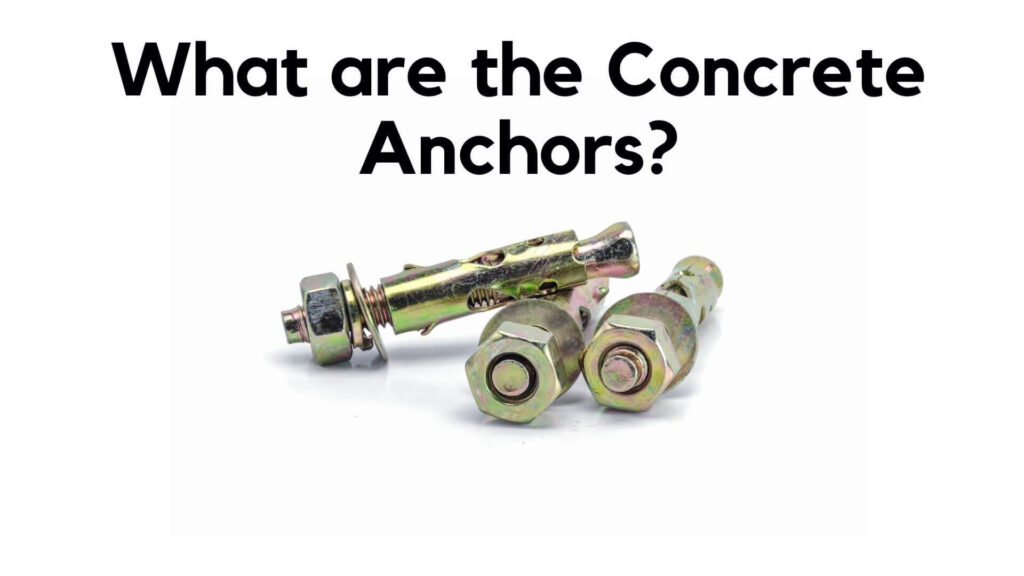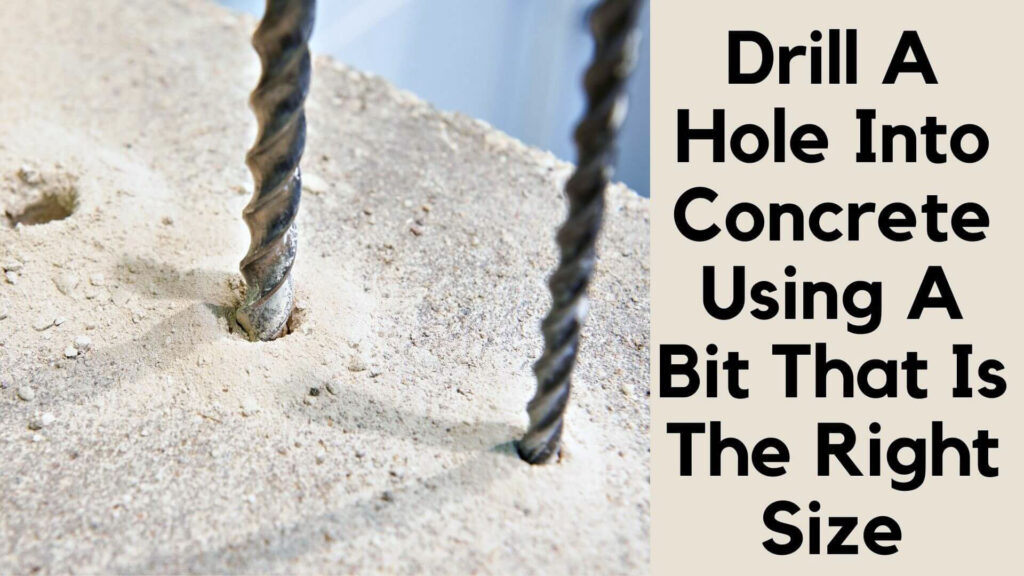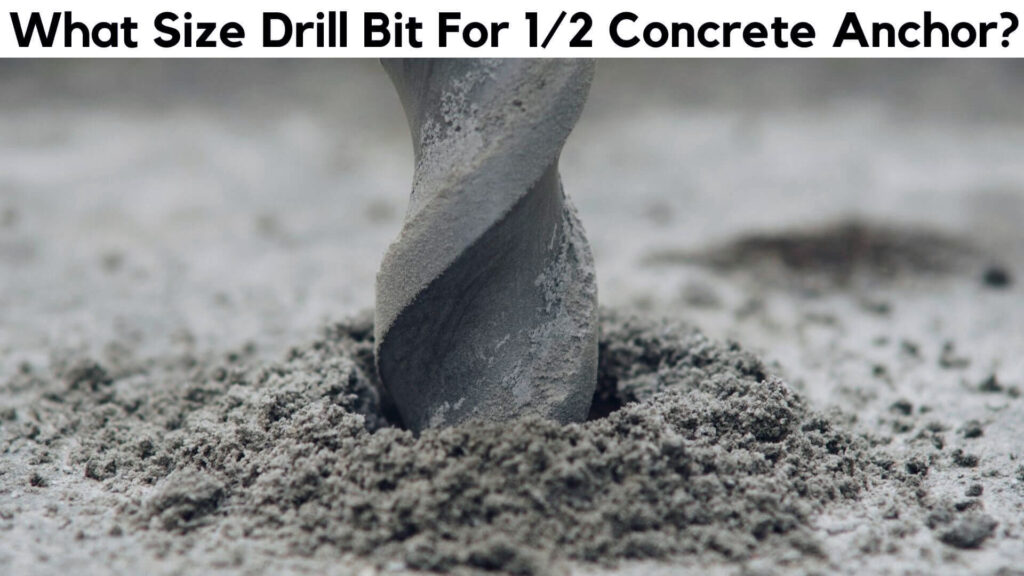When considering which size drill bit to use for drilling into concrete, there are a few factors to consider. One of the most important factors is the anchor size you are planning to install.
With so many different types of anchors in the market, it can be hard to choose the right size drill bit for your concrete project. This guide will walk you through the different types of anchors and how to choose the right size drill bit for each one.
Table of Contents
What are the Concrete Anchors?

Concrete anchors are special screws that are used to secure concrete in place. They come in a variety of sizes and can be used with either dry or wet concrete.
Concrete anchors are typically rated for use with a range of depths and can be found in both standard and heavy-duty configurations.
What Size Drill Bit Is Best For 1/2 Concrete Anchor?
When drilling into concrete, it is essential to use the correct size drill bit. This will ensure that the bit does not break through the anchor and cause any damage. It is also necessary to use a drill bit that is the correct size for your concrete.
The best size drill bit for drilling into a 1/2 inch concrete anchor is a carbide-tipped bit that meets ANSI Standards B212. 15. The hole you prepare should be 1/2 inch deep, and the anchor should penetrate the concrete with a minimum embedment of 2-1/4 inches.
If you are using a drill without a built-in gauge, you can use this chart to determine the size of your drill bit:
| Diameter Of Anchor | Space Between Anchors | Max Edge Distance |
| 1/4″ | 3-1/2″ | 1-3/4″ |
| 3/8″ | 5-11/16″ | 2-13/16″ |
| 1/2″ | 7″ | 3-1/2″ |
| 5/8″ | 8-5/16″ | 4-1/8″ |
| 3/4″ | 10-1/2″ | 5-1/4″ |
Read More: The Complete Guide To Using Left Hand Drill Bits Effectively
What Size Drill Bit Is Best For 1/2 Concrete Wedge Anchor?
With so many different types of anchors in the market, it can be hard to choose the right size drill bit for your concrete project.
When drilling into a concrete surface, always use the correct size for the material drilled.
The best size drill bit for drilling into a 1/2 inch concrete wedge anchor is a carbide-tipped bit that meets ANSI Standards B212. 15.
The hole you drill should be 1/2 inch deep, and the wedge anchor should penetrate the concrete with a minimum embedment of 2-1/4 inches.
Read More: The Ultimate Guide To Choosing The Right Split Point Drill Bit For Your Project
What is The Minimum Embedding Requirement?
The minimum embedding requirement is the depth of the hole in the concrete that must drill to embed the self-tapping screw.
The screws must go through the concrete and into the ground to provide a stable foundation. There are three types of screws that are used for anchors:
- Self-tapping screws: Self-tapping screws are inserted into the hole with a screwdriver and then tapped with a hammer to create an anchor.
- Imperial screws: imperial screws have an extra thread on one end that is used to screw into concrete.
- Lag screws: Lag screws have two threads on opposite ends that can be screwed together to form an anchor. Lag screws have two lines on opposite ends that can be screwed together to create an anchor.
The minimum embedding requirement for lag screws is 1/2 inch, but it depends on the type of lag screw being used. For example, the minimum embedding requirement for hex head lag bolts is 3/8 inch.
Different types of anchors are available depending on what kind of soil you are using and what type of construction you are doing.
The minimum embedment requirement is the minimum distance the bit must penetrate the concrete to be effective. The minimum embedment requirement for a 1/2 inch concrete anchor is 2-1/4 inches.
Why is it Important to Use the Correct Drill Bit Size for Your Anchors?
There are many different types of anchors on the market, and various factors can affect the kind of anchor best suited for your needs.
For example, concrete anchors may be a better choice if you are working with a soft surface like wood or brick.
On the other hand, steel anchors may be more appropriate if you are working on concrete or stone surfaces.
An improperly sized drill bit can lead to anchor failure. Using the right drill bit for your anchor is essential, as an improperly sized drill bit can lead to anchor failure.
If a drill bit is too tiny, it will damage the threads of the anchor and cause premature failure. If a drill bit is too large, You will not adequately fix the anchor, which may move or come out.
How To Drill A Hole Into Concrete Using A Bit That Is The Right Size

Now that you know the correct size drill bit for 1/2 inch concrete anchors, it is time to learn how to drill the hole. Follow these simple steps:
1. Clean and dry the area where you plan to drill.
2. Insert the bit into your drill’s chuck and tighten the bolt.
3. Position the bit over the hole you want to drill and center it in the target area.
4. Push down on the trigger and start drilling. Keep a steady pace as you go so that you don’t damage your bit or your concrete surface.
5. When you reach the desired depth, stop drilling and remove the bit from the drill.
6. Clean the hole and the bit with a damp cloth.
7. Install the anchor using the correct size drill bit.
Read More: 6 Easy Steps To Drill Through Porcelain Tile Without Cracking
FAQS About What Size Drill Bit For 1/2 Concrete Anchor?
What is The ANSI Standards B212.15?
The ANSI Standards B212.15 is a set of standards that govern the dimensions of carbide-tipped bits. This standard determines what size drill bit you should use for a 1/2 inch concrete anchor.
What is The 1/2″ Hole Size?
The 1/2″ hole size is the size of the hole that the bit will create when drilling into concrete. Most carbide-tipped bits have a 1/2″ hole size.
What is The bit Size for a 1/2″ Hole?
The bit size for a 1/2″ hole is usually either a 6 or 8-millimeter bit size.
What is The Bit Size for a 1/4″ Hole?
The bit size for a 1/4″ hole is usually a 3 or 4-millimeter bit size.
What is The Bit Size for a 3/8″ Hole?
The bit size for a 3/8″ hole is usually a 5 or 6-millimetre bit size.
Last Thought
This guide explains the different types of anchors and how to choose the right size drill bit for each one. We have also demonstrated the minimum embedment requirement and the 1/2″ hole size. Finally, we have provided a guide on choosing the correct bit size for a 3/8″ hole.

Hey, I am MD Hrithik Hossain, I’m a huge fan of DIY crafts. My workshop is where I spend most of my spare time, and I’m always working on some project. To that end, I’d like to share some of my knowledge and experience with you in power tools, woodworking, and other specialized materials fabrication.
I will guide you with genuine knowledge that can assist you with deciding whether a drill is appropriate according to your requirements or not. If you want to find the best drill and know which type of drill is most suited for your needs, then I can guide you with my expertise. My passion lies in helping others find the correct products they need at an affordable price.


